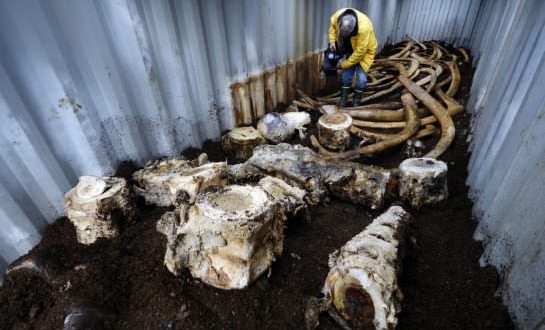Some day, the dead blue whale will be the centrepiece of a Royal Ontario Museum exhibit worthy of her antemortem status: She was once a queen of the deep.
But for now, the indignities visited upon Lollipop, as the dead whale is affectionately known to those who flensed her massive skeleton in Newfoundland last May, continue to pile up. This week they piled up literally as her skeleton was buried in manure in Trenton, Ont.
Mark Engstrom is the museum’s deputy director of collections and research, and is in charge of the projects that saw the retrieval of skeletons from the carcases that washed ashore in Trout River and Rocky Harbour.
He said several of the containers have been modified so that oxygen can be pumped inside to help with composting. After sitting like this for the winter, Engstrom expects most of the bones to be cleaned by late next spring.
Typically, beetles are used to clean smaller skeletons but Engstrom said the 80-foot whales are much too big for such a method.
“There’s so much flesh that beetles can’t handle it,” Engstrom said.
“The best biological way to clean the flesh off is to do it with composting.”
The team has used the method with success on large specimens such as a rhinoceros, an elephant and assorted whales.
Engstrom said he’s worked on a 55-foot fin whale, a mammal he says is nowhere near as bulky as the blue whale carcases.
“It’s just massive … it feels like it’s two to three times as big,” he said. “Compared to the fin whale, there’s really no comparison.”
Both whales are being cleaned at the same time but Engstrom said each of the bones have been carefully labeled so there is no mix-up when the time comes to reconstruct the skeletons.
Once the bones are cleaned, a dry cleaning procedure will be used before they are ready to be reassembled.
When completed, one of the skeletons will remain at the museum while the other will be shipped back to the province, thanks to a partnership with Memorial University.
Engstrom said the lengthy process can test one’s patience, but ultimately the work will be worth it.
“If I was doing this on a mouse, I would be done in a day,” he said with a chuckle. “But this is going to take me a couple of years to do because the whales are so big.”
Agencies/Canadajournal
 Canada Journal – News of the World Articles and videos to bring you the biggest Canadian news stories from across the country every day
Canada Journal – News of the World Articles and videos to bring you the biggest Canadian news stories from across the country every day



